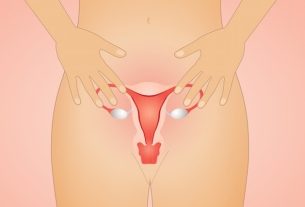Some signs that indicate that your water has broken are the release of a transparent or light yellow, odorless liquid from the vagina, which can come out in small quantities as a drip or come out in large quantities and constantly.
When your water breaks, the ideal is to remain calm and go to the hospital, as it indicates that the baby will be born. Furthermore, it is recommended to inform the obstetrician or go to the hospital whenever there is a suspicion of a water break, as any break, no matter how small, can facilitate the entry of microorganisms, affecting the baby and the woman.
Water rupture is when the amniotic sac, which is the membranous sac that surrounds the baby, ruptures and releases the fluid inside. In general, this is one of the signs that appear at the beginning or during labor. Know how to identify all the signs of labor.

How to know if your water has broken
When the bag bursts, a clear or light yellow, odorless liquid is released, the release of which cannot be controlled and may come out in large or small quantities constantly. It is not always possible to identify when your water breaks and, therefore, it is important to contact your doctor whenever you have any doubts about the break.
Normally, a few days before the water breaks, the woman feels the expulsion of the mucous plug, which is a thick, yellow secretion responsible for covering the cervix, protecting the baby. In some women, this tampon may be mixed with blood and come out with some red or brown dots, as if it were the end of menstruation.
What to do
As soon as the water breaks, it is important that the woman does not panic, and it is recommended to put on a night pad, as this way the doctor will be able to know what color the liquid is, in addition to having an idea of the amount of liquid that was lost, assessing whether there is some risk to the woman or the baby.
It is then recommended to consult the doctor who is monitoring the pregnancy or go to the maternity ward to have an ultrasound done so that it is possible to find out the amount of amniotic fluid lost, as well as assess whether the baby is well.
What to do if your water breaks before 37 weeks?
When your water breaks before the 37th week of pregnancy, known as premature rupture of membranes, it is important that the woman goes to the hospital as soon as possible so that an assessment can be carried out.
Generally, some factors can contribute to the water breaking before the 37th week of pregnancy such as history of premature rupture of the membrane in the previous pregnancy, inflammation in the fetal membranes, intra-amniotic infection, vaginal bleeding during the 2nd or 3rd trimesters, drug use from abuse or smoking during pregnancy, poor nutrition or short cervical length, for example.
What to do when your water breaks and there are no contractions
When the water breaks, it is expected that the uterine contractions that mark the beginning of labor will appear within a short time, generally occurring around 5 hours after the water breaks. However, contractions can take up to 48 hours to appear, however, it is recommended to go to the maternity ward within 6 hours of the water breaking because this break allows microorganisms to enter the uterus, increasing the risk of infections in the woman and the baby.
At the hospital, the doctor may wait a few hours to check whether the contractions begin spontaneously, offering antibiotics to reduce the risk of infection, or he may induce normal birth with the use of synthetic hormones or initiate a cesarean section, depending on each case.
Warning signs
If the water breaks and the woman has not yet gone to the maternity ward, it is important to pay attention to the following warning signs:
- Decreased baby movement;
- Change in the color or smell of amniotic fluid;
- Presence of blood;
- Presence of fever, even if low.
These situations can indicate complications for the woman and the baby and, therefore, it is important to seek medical help immediately or the nearest emergency room if the woman presents these signs.
When to go to the maternity ward
It is recommended to go to the maternity ward when your water breaks before 37 weeks of gestation, up to 6 hours after your water breaks (when a natural birth is desired) and immediately if your water breaks before the cesarean section date scheduled by your doctor.
Bibliography
- BELLUSSI, F.; et al. Timing of induction for term prelabor rupture of membranes and intravenous antibiotics. Am J Obstet Gynecol MFM. 3. 1; 100245, 2021
- LOBATO, Luis Gerardo Rodriguez; et al. Manuel MIP 3: Undergraduate Internal Medicine. 3ed. Mexico: Intersistemas S. A, 2020. 260-264.
- MIDDLETON, P.; et al. Planned early birth versus expectant management (waiting) for prelabour rupture of membranes at term (37 weeks or more). Cochrane Database Syst Rev. 1. 1; CD005302, 2017
- SIBIUDE, J. Rupture of membranes at term before labor. CNGOF recommendations for clinical practice — Should we trigger? (Term Prelabor Rupture of Membranes: CNGOF Guidelines for Clinical Practice – Timing of Labor Induction). Gynecol Obstet Fertil Senol. 48. 1; 35-47, 2020
- Committee on Practice Bulletins-Obstetrics. ACOG Practice Bulletin No. 188: Prelabor Rupture of Membranes. Obstet Gynecol. 131. 1; e1-e14, 2018

Sign up for our newsletter and stay up to date with exclusive news
that can transform your routine!
Warning: Undefined array key "title" in /home/storelat/public_html/wp-content/plugins/link-whisper-premium/templates/frontend/related-posts.php on line 12
Warning: Undefined array key "title_tag" in /home/storelat/public_html/wp-content/plugins/link-whisper-premium/templates/frontend/related-posts.php on line 13





